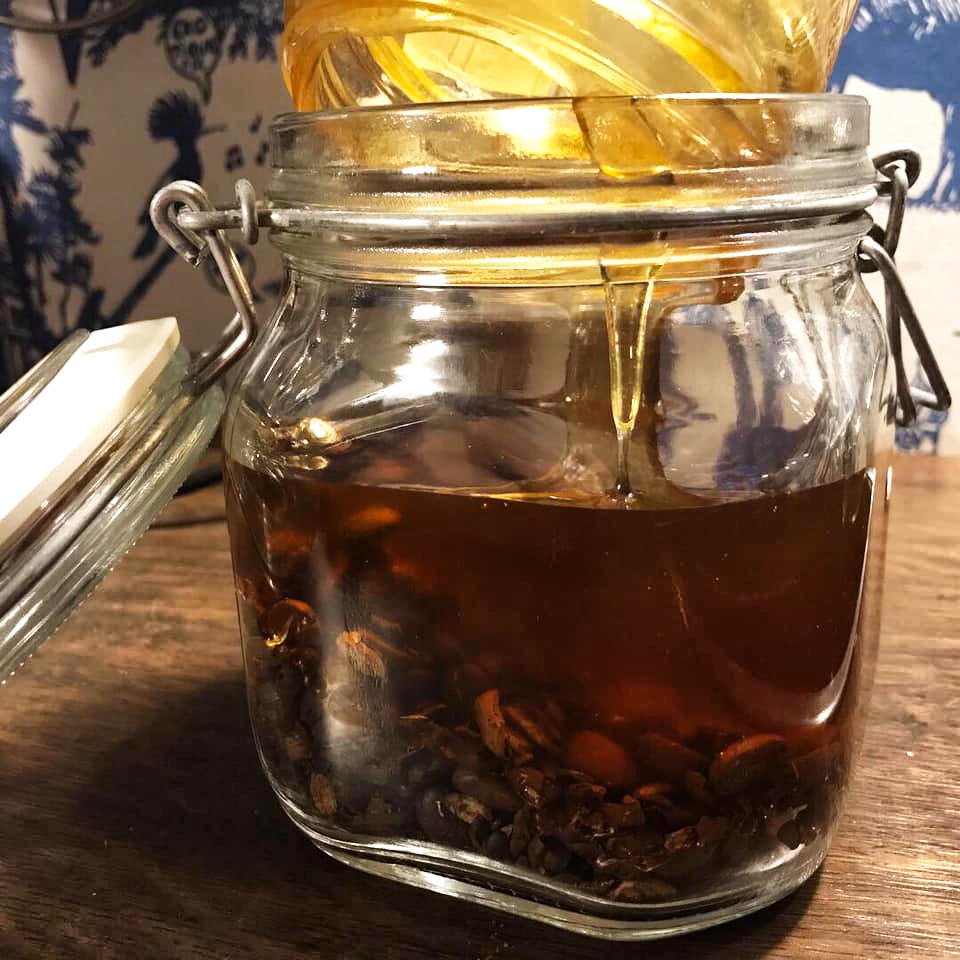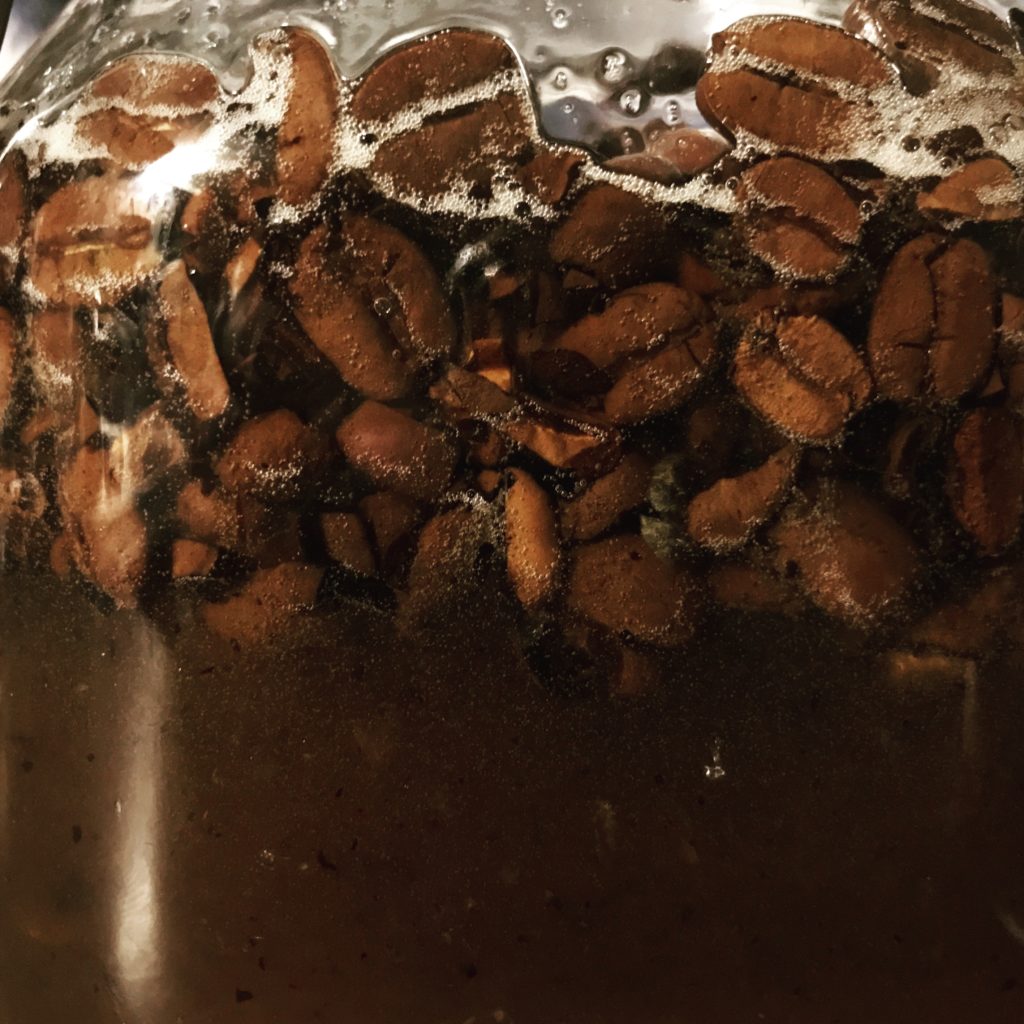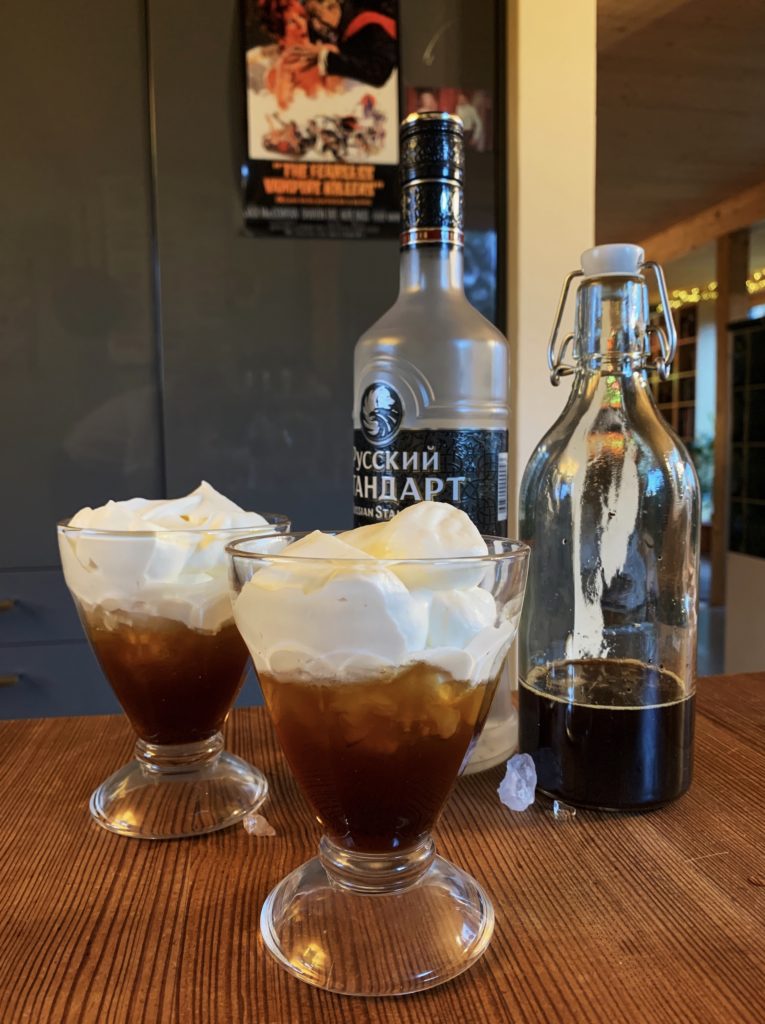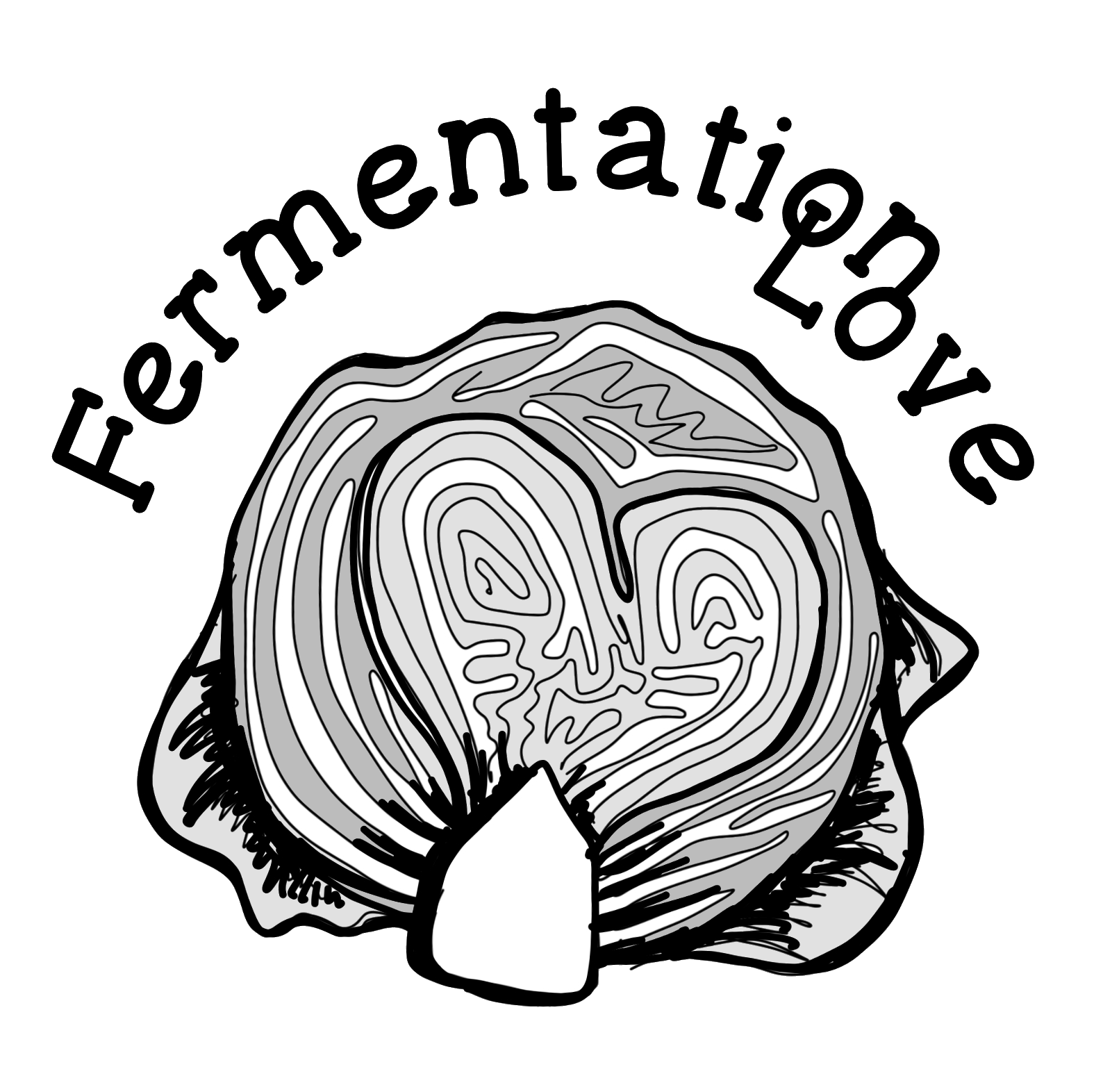Katsulua is fermented coffee-honey liquor.
Another fabulous honey ferment! Of course, you don't have to ferment everything, but the fact that you can ferment coffee so successfully, in addition to the fabulous kombucha variety, causes long-term enthusiasm in me - fermented coffee!
Due to the alcohol and caffeine content, this ferment is not suitable for children. How much alcohol is involved, I can only estimate, liqueur-like alcoholic drinks can not be measured precisely because of the sugar content. Taste and effect indicate around 10%, less or more. So once again: Absolutely only for adults.
The idea for this liqueur comes from the fabulously creative Michelle Knox.
INGREDIENTS
- 500 gr. raw local honey
- 100 gr. coffee beans, partially ground
- 150ml H2O
This ferment is a bit like flavoured mead. Mead is a traditional honey wine, fermented from honey and water. A rule of thumb for making mead is that from about half of the honey on water a sweet drink, from a quarter honey a rather tart drink is produced. Meaning that you can play with the water content. I do not recommend less than the 30% mentioned above for this ferment nevertheless.
I always use Fairmaster Arabica for this ferment because I like fair trade coffee and I have it at home. Other coffees will certainly work, too.
PREPARATION
Coarsely crush some of the coffee beans. Mix the coffee with the honey in a flip top jar. This is easier when the honey is still at least viscous. Since the coffee does not release any water, we need to add it and stir quite thoroughly, the first 1-2 days ideally in the morning and in the evening.
Coffee in honey can be quite an active ferment with lots of wonderful bubbles, depending on the temperature and the composition and number of wild yeasts and other microbes. In that case, it is important that you release carbon dioxide from your fermentation vessel every day at the start of fermentation (even if you use a swing-top jar), otherwise too much pressure will be created. Sometimes, however, fermentation is slower and less active, which means it is not necessary to open the jar. Observe your ferment well and decide from there, and I'd rather open too much once than have honey on my face or a bursting jar.


In the beginning, turn the glass several times a day so that the coffee beans are repeatedly coated with honey. Afterwards, some honey will tend to come out of the cracks between the glass and the lid. Of course also with a time delay. This ferment is a rather sticky matter... The best thing is to put it on a tray and clean the outside of the glass from time to time. If the development of bubbles is decreasing, there is no need to turn the glass over anymore.
After 5-6 months, strain and pour into a swing glass bottle.
Enjoy straight or refine with vodka and cream to make a White Russian.

Katsu’s White Russian
- 4 cl Vodka
- 4 cl fermented coffee-honey liquor
- 2 TBSP whipped cream
- Ice cubes
Stir Vodka and Katsulua on ice to cool down. Top off with whipped cream and serve with a coffee spoon.





Hallo,
mit großem Interesse habe ich gerade die Rezepte angesehen. Mir ist aufgefallen, dass immer von unbehandeltem Honig die Rede ist. In Deutschland ist Honig immer unbehandelt! Das schreibt schon die Honigverordnung vor. Um Honig zu gewinnen muss ich ihn schleudern, rühren um ihn cremig zu bekommen und dann, zum Abfüllen in Gläser, wieder fließfähig machen (erwärmen auf nicht über 40 Grad). Sollte ich Honig direkt nach dem Schleudern in Gläser abfüllen, dann kristallisiert er (bei der Frühtracht) bereits nach 2-3 Tagen und wird sehr fest.
Hej Dieter,
über die Erläuterung freuen sich bestimmt etliche Leute, danke. Ich schreibe dazu, dass es unbehandelter Honig sein muss, weil diese Seiten nicht nur in Deutschland gelesen werden, sondern in sehr vielen Ländern, die teilweise andere Regularien bezüglich des Honigs haben.
Viel Erfolg beim Fermentieren!
Katsu
Danke, liebe Katsu! Ich werde dann vor dem Umfüllen in Geschenkgläser alles pürieren. Gute Idee!
Hallo Katsu, mein Fermet ist fertig. Danke für das tolle Rezept. Was machst du mit den Kaffeebohnen?
Viele Grüße
Rösten und als Crunch benutzen! Schmeckt Dir der Katsulua?
Hey Katsu 😁
Ich habe dieses Rezept als Basis genommen, aber statt Kaffeebohnen Orangen 🍊 und Zitronensaft 🍋 verwendet. Plus Lebkuchengewürz. Das ganze war jetzt ca 3 Mt am blubbern. Vor 3 Tagen wurde es ruhiger. Hab das Orangenzeugs rausgefischt und alles durch ein Tuch gefiltert. Es ergab ca 2,5 Liter. 2l hab ich in zwei Bügelflaschen gefüllt. Der Rest musste verkostet werden 😅😂. Mir schmeckt es sehr gut. Auf crushed ice, erfrischend und nicht zu süss.
Liebe Grüsse
Manuela
Hej Manuela,
so ähnlich funktioniert die fabelhafte Essence of X-Mas meiner Freundin Payal, sie hat unter ihrem Fermentista-Namen kōbo fermentary sogar ein YouTube Video dazu veröffentlicht.
Ich mache das jeden Winter, es schmeckt supergut als Glühweinwürze oder zum Backen. Im Sommer auf crushed Ice ist eine tolle Idee von Dir, das probiere ich auch mal aus!
Danke fürs Teilen,
Katsu
Hallo liebe Katsu,
danke für das tolle Rezept. Klingt sehr lecker, ich will es nachher ansetzen!
Aber ich bin nicht ganz sicher, ob ich insbesondere die beiden letzten Punkte unten richtig interpretiere:
• je mehr Honig, desto süßer
• empfehlenswerte Wassermenge mindestens 30% der Honigmenge
• es geht aber auch umgekehrt: 75% Wasser, 25% Honig – dann eher herb
• ab 50% Honig, 50% Wasser – eher süß / oder 33% Honig auf 66% Wasser (Honig Hälfte des Wassers)?
Vielen Dank und liebe Grüße, Sina
Hej Sina,
die angegebenen 150 ml auf 500 gr. Honig ergeben ein süsses, alkoholisches Getränk, was nicht zu heftig gärt und deswegen ohne Gärspund zu machen ist. Wenn du mit dem Wassergehalt spielen möchtest, vergleiche bitte hier https://www.c-schliessmann.de/media/honigwein_met_07_2019.pdf.
Gutes Gelingen, und berichte gerne über dein Ergebnis!
Katsu
Hallo Katsu,
vielen lieben Dank! Mache ich gern dann.
Liebe Grüße, Sina
Hallo Kaktus, wie viel Alkohol ist nach den Fermentieren im Kaffeelikör und wie kann man so etwas messen ( mit welchen Gerät). Die Messung wäre auch beim Essig interessant.
Hej Mori,
eine zuverlässige Alkoholgehaltmessung kannst du zuhause eigentlich nicht durchführen. Die dafür nötigen Geräte sind groß und teuer. Ich schätze Zucker- und Hefegehalte und versuche dann, den Alkoholgehalt auszurechnen und überprüfe das Ergebnis mit meinem Geschmackssinn.
Gutes Gelingen,
Katsu
Hallo Katsu, danke für die Hinweise, werde ich mal versuchen.
Lg
Mori